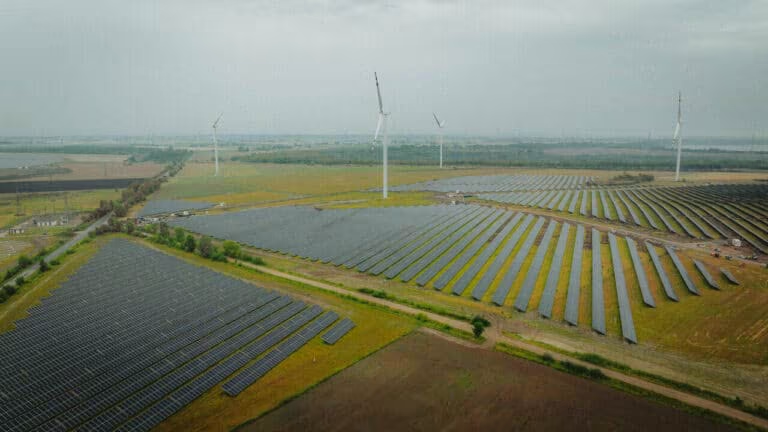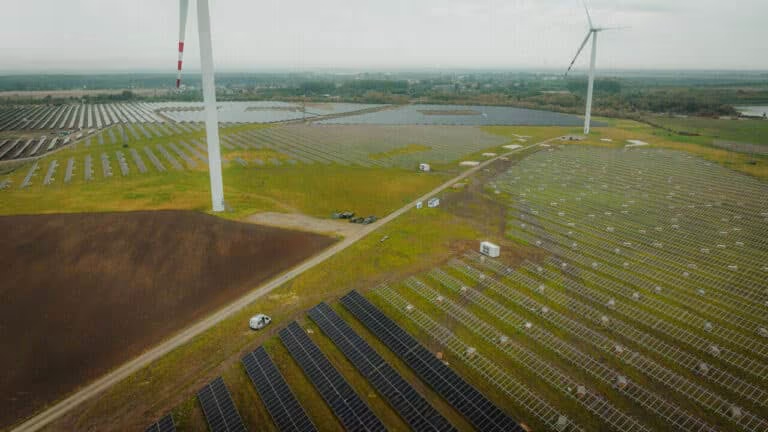Hybrid renewable energy systems are facilities that use more than one source of clean energy generation. These are advanced systems that combine different renewable technologies, such as solar and wind energy, to increase production efficiency. In Poland, due to favorable weather conditions, we most often invest in solar and wind energy.
In the long term, we can expect various combinations of energy sources, such as water-sun or water-wind connections. However, at the moment, the most accessible and efficient solution is a combination of solar and wind energy, which complement each other perfectly, enabling stable energy production throughout the day.
One of the first large-scale hybrid power plant in Poland is the Kleczew Solar & Wind Park.

We talk with Kamil Kozicki, an expert from Electrum, about Kleczew and explain how modern hybrid installations contribute to the energy transition. We also discuss the current legal status of such installations and the reasons why investing in them is worthwhile.
How does the Kleczew Solar & Wind Park work?
In Kleczew, we have two integrated energy sources: a photovoltaic (PV) farm and a wind farm. The PV farm has a maximum capacity of 193 MW (AC), with an installed capacity in the PV modules of 250 MWp. This means that the system is oversized by 30%, allowing for stable energy supply even under varying weather conditions. The second facility, the wind farm, consists of four Nordex N133 turbines, each with a capacity of 4.8 MW, totaling 19.2 MW of installed capacity. However, due to connection limitations, we can currently only deliver 11.7 MW of wind power. The connection capacity, or the maximum power we can deliver to the grid based on the connection agreement, is 204 MW for both energy sources combined.
The common point of connection between the PV farm and the wind farm is the Main Offtake Point (GPO). Thanks to the hybrid installation, the energy produced by these farms is transmitted via a single high-voltage cable. This optimizes transmission infrastructure and reduces costs.
How does Kleczew stand out among other hybrid facilities in Poland?
It is the first farm on such a large scale. The first with connection terms issued that explicitly indicate two energy sources in the connection agreement. This means it was clear from the beginning that this is a hybrid facility. Previously, micro-installations combining photovoltaics with a few wind turbines were developed, but here we have a large-scale facility with 250 MWp of solar power and 19.2 MW of wind power (installed capacity). The facility is controlled by Electrum’s proprietary solution, the Renedium master controller, enabling the creation of a unique ecosystem.
Read more: Renedium
So, before Kleczew, connection agreements did not include two energy sources?
Until now, the connection agreements and connection terms I dealt with at Electrum specified a single energy source. Kleczew is the first wind solar farm we have implemented where two energy sources are explicitly defined – it was designed and implemented as a hybrid installation.
A single transmission line for two sources is also used in cable pooling. How do hybrid installations differ from cable pooling?
Both approaches aim to optimize the use of renewable energy, but they differ in methods and infrastructure. Cable pooling focuses on using transmission infrastructure by sharing a single line between different renewable energy installations. However, these installations are independent of each other and cannot fully utilize their potential. Therefore, wind solar farms go a step further. They integrate different renewable technologies in one location to increase the reliability and efficiency of energy production. It is an entire system designed to complement each other and work together.
Kleczew is designed to effectively utilize the available renewable energy resources under different weather conditions. Both installations operate simultaneously. When the PV farm is not working due to weather conditions or time of day, the wind farm operates, and the facility continues to generate renewable energy, ensuring continuous production.
In cable pooling, the wind farm could share a line with the photovoltaic farm, using the same transmission infrastructure to reduce costs, maximize productivity, and increase profits for the investor. As a solar wind hybrid system, Kleczew not only shares infrastructure but also combines different renewable energy technologies in one location. Photovoltaic panels and wind turbines are integrated to complement each other, providing more stable and efficient energy production throughout the day. Moreover, as I mentioned, the agreement clearly defines that it is a facility with two energy sources.
What is the process of testing and commissioning a hybrid facility?
We are subject to standard network code procedures that we must follow. These apply to all stages, from obtaining permission to energize (EON), through temporary permission to operate (ION), to final operational permission (FON). At Electrum, we comprehensively carry out all the procedures necessary to commission the facility, from conducting necessary simulations to performing compliance tests. To ensure everything runs smoothly, SCADA-type software* is also required. In Kleczew, Electrum’s proprietary solutions – the EMACS software and Renedium, which houses a built-in master controller that integrates all energy sources, overseeing and controlling them.
* Supervisory Control And Data Acquisition
Read more: EMACS
What problems do solar wind hybrid power solve?
A wind farm can operate continuously, regardless of day or night, depending on wind conditions. The solar farm, on the other hand, operates at specific hours, dependent on the sun. The key word here is efficiency. Primarily, hybrid installations allow more efficient use of connection capacity and, to some extent, can substitute solar with wind or wind with solar. In Kleczew, we have not yet fully utilized the connection capacity, and together with the investor, we are working towards that goal.
Does Electrum intend to focus on renewable energy hybrid systems?
We will certainly encourage investors towards such solutions. It is an attractive prospect – fully utilizing connection capacity and maximizing profits. There are projects under discussion, such as adding wind turbines to an existing solar farm.
What currently holds investors back from hybrid projects?
Primarily issues related to connection agreements and issuing technical connection conditions. The process requires the investor to first approach the electricity network operator and obtain approval for a renewable energy hybrid systems. At this stage, various nuances arise, such as the definition of a hybrid installation and the lack of uniform regulations. Whether it will be a hybrid, where a wind farm is expanded with solar power or vice versa, or a new independent installation connected to another in a cable pooling option. Currently, regulations governing hybrid installations are in the process of being developed. There is a lack of uniform, general guidelines that clearly define technical requirements, procedures, and standards. As appropriate regulations develop and support for hybrid projects increases, these barriers may gradually be reduced. This will open the door to broader application of hybrid installations. Of course, this does not mean that the current barriers cannot be overcome. Kleczew is the best example of this.
Which country sets a good example?
A great example from abroad is Denmark, a leader in hybrid power plants. Denmark successfully operates hybrid renewable energy farms that combine wind turbines with photovoltaic installations and energy storage systems. For example, the hybrid farm in Lem Kær, which integrates various renewable energy sources and energy storage systems.

An energy storage system is also planned for Kleczew. How will energy storage impact the installation?
Introducing energy storage will allow us to overcome the current limitations imposed on the farm. The photovoltaic farm in Kleczew has a capacity of 250 MWp, of which we can effectively use 193 MW. A similar situation applies to the wind farm – out of four turbines with a capacity of 4.8 MW each, we can effectively use only 11.7 MW. These limitations result from the connection agreement. The facility can continue to be expanded. Currently, we have 204 MW of connection capacity, and we are ready to continuously transmit 240 MW to PSE.
Energy storage will allow excess energy that currently cannot be transmitted to the grid due to contractual limitations to be stored. In practice, this means that surplus energy that cannot be directly utilized will be stored. In moments when energy production from solar and wind is lower, the energy storage system will be able to release the stored energy to the grid. This will allow for more consistent energy delivery to the grid, avoiding sudden drops and spikes in power.
Energy storage will enable more efficient management of the farm’s energy production. Solar energy is produced mainly from late morning to early afternoon, after which it decreases. Wind energy production, on the other hand, can be more variable. Energy storage will smooth out these fluctuations, allowing energy to be delivered to the grid in a more stable and consistent manner.
Introducing energy storage also opens up possibilities for further expansion of the farm. With energy storage, we can increase the installation’s capacity. Excess energy can be stored and used during times of higher demand. For example, if we have 204 MW of connection capacity, the storage system will allow us to maintain maximum power for longer periods under ideal conditions at midday when energy production is highest.

Are hybrid renewable energy systems the future of renewable energy? Is this the direction in which renewable energy will expand more broadly?
It is certainly one of the directions. It all comes down to making these energy sources as flexible and efficient as possible. The demand for energy from the grid is not uniform. There are hours when energy is needed more, and others when it is needed less. The broader application of hybrid farms, additionally with energy storage, will allow for better alignment with demand.
Another related issue is the distribution network in Poland. We have problems with energy transmission. On weekends, there is usually too much energy. That’s the situation we have. The operator does not want to receive this energy on weekends and signals to shut down or limit production from the farm. In the worst case, penalties and negative energy prices may appear during this time. If we have a hybrid renewable energy systems with energy storage, we can adapt our production to the conditions – shut down or reduce the power of the photovoltaic installation while the wind farm continues to operate.
The hybrid power plants can also operate entirely independently of the grid. With energy storage, we can store energy and utilize it according to our needs without relying on the grid operator.
In the long run, we can expect hybrid power plants to become more widespread. Investors and operators will increasingly rely on these advanced energy solutions. Hybrid systems can provide more flexible and efficient energy production, especially with energy storage, and become an important part of Poland’s energy mix.
If you have any further questions, feel free to contact us.







